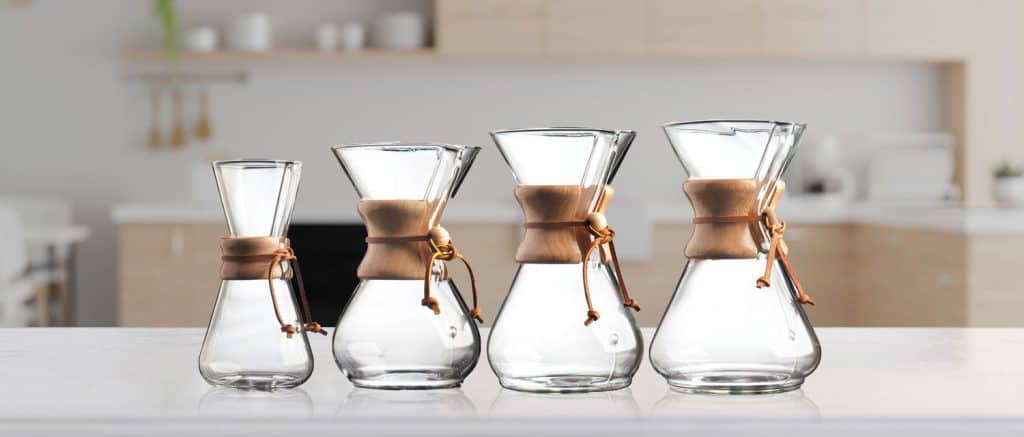Hario V60 vs Chemex – Which Pour-Over Is Better?
When it comes to pour over coffee, there’s no doubt that the Hario V60 and Chemex come out on top. But the question remains, which brewer is better?
I’ve been a fan of both brewing devices but now, it’s time to finally decide which coffee maker is better than the other.
In this article, I’ll dive into the nitty-gritty details and compare the Hario V60 and Chemex head-to-head so you can finally decide which one would be best suited for your morning brew ritual.
Comparing Hario V60 & Chemex
The Hario V60 is a pour over coffee maker with a unique 60° angled conical dripper invented in the 2000s. This method involves pouring hot water onto the ground coffee in a filter placed in the cone-shaped brewer, and allowing it to drip through into your mug or carafe below. The V-shaped design and the circular ridges in the cone promote even extraction.
On the other hand, the Chemex is a classic manual pour over coffee maker invented in the 1940’s. It is made out of borosilicate glass shaped like an hourglass. Using a filter designed specifically for the Chemex, you add ground coffee to the top section and slowly pour hot water over it. The coffee then filters through the paper and collects in the bottom chamber.
Here are the factors to consider when picking between the two brewing methods, followed by a detailed comparison of each feature:
| Features | Hario V60 | Chemex |
|---|---|---|
| Taste & Flavor | Clean and vibrant brew | Smooth and light-bodied with subtle sweetness |
| Strength | Variable strength levels | Medium strength |
| Ease of Use | Moderate learning curve, requires pouring technique | Slightly easier to master, less pouring technique required |
| Brewing Speed | 5-7 minutes | 5-7 minutes |
| Versatility | Adjustable grind size, water temperature, pouring speed, and technique | Adjustable grind size, water temperature, and pouring rate |
| Sizes | Three sizes available: 01 (1-2 cups), 02 (1-4 cups), 03 (1-6 cups) | Four sizes available: 3-cup (16 oz), 6-cup (30 oz), 8-cup (40 oz), 10-cup (50 oz) |
| Durability & Portability | Ceramic, glass, steel, copper, or plastic options, portable | Heat-resistant glass, delicate, not recommended for travel |
| Sustainability | Use of paper filters (can be replaced with reusable filters), plastic variants | Glass system, wooden collar, compostable paper filters (reusable options available) |
| Cost | Affordable ($10-$50), recurring cost of filters ($0.08 per filter) | Slightly more expensive ($40-$60), higher cost of filters ($0.16 per filter) |
For more details on each brewer, check out my guide to the Chemex, and this Hario V60 guide as well.
Now onto the details.
Taste, Flavor, & Strength
When it comes to flavor and strength, the Hario V60 shines bright in producing a clean and vibrant brew. This is due to its unique design that allows for optimal extraction of the coffee bean’s flavor notes. With the right beans, you can get anything from a light cup with delicate, fruity and floral notes. It is almost tea-like.
The Chemex produces a smooth and light-bodied cup as well with just enough sweetness to make it enjoyable without adding any additional flavors or sugar. The thicker filters provide an extra layer of filtration for even cleaner-tasting coffee. However, compared to the Hario V60, the Chemex’s intensity level tends to lean more toward medium strength. It is not as soft as the V60, but is more balanced between sweetness, flavors, acidity, and bitterness.
The differences are small, but if you ask me, I appreciate brewing with the V60 more because the way it extracts unique flavors from each bean really makes the difference. But Chemex doesn’t disappoint either, delivering consistent results that I could honestly enjoy any day.
Ease of Use
Now let’s look at how easy the brewers are to use.
The brewing process for the Hario V60 and the Chemex is very similar. Being pour-over, it is an “involved” process, meaning you have a lot to do before and during the brew. It may even seem intimidating at first, but once you get the timings and pouring method down, it’s a breeze to use.
The main difference between their use is the grind size. The V60 is best with medium-fine ground coffee along with 195°F to 205°F water temperature for optimal extraction.

The Chemex, on the other hand, is best with medium-coarse ground coffee poured with water at around 200°F.

So which one is easier to master? There’s little difference between the two methods but I’d say that the Chemex has a smaller learning curve by just a bit, since the thicker paper filter makes it more forgiving. It’s easier to produce a consistently delicious drink with this brewer compared to the V60.
Brewing Speed
In terms of brewing speed, both the Hario V60 and Chemex take around 5 to 7 minutes in total from grinding to brewing and cleaning. However, there are some noteworthy differences between the two that could affect your brewing experience.
Let’s start with the Hario V60. With this method, you’ll need to let the coffee grounds bloom for 30 seconds before pouring the rest of the water for roughly 3 to 4 minutes. Once your cup is brewed and enjoyed, cleaning up is fairly easy; all you really need to do is give the filter cone and carafe a good rinse.
Brewing with the Chemex system takes slightly longer than the V60 because the thicker filter takes time to extract your coffee. On top of that, washing out the glass vessel requires some delicate handling in order to avoid any accidental cracks or damage. Despite these minor hurdles, cleaning up after using a Chemex isn’t too much trouble as long as you’re careful.
If it’s about faster brewing, this category can be deemed a draw. It is worth noting though that the V60 is easier to clean up than its bigger counterpart.
Versatility
Brewing versatility is crucial as it allows us to experiment with different brewing methods and techniques to achieve a personalized cup of coffee. When comparing the Hario V60 and Chemex, both pour-over methods provide ample control over the extraction process, but there are some notable differences in terms of versatility.
The Hario V60 offers a decent amount of control due to its design; its internal ridges help regulate the flow rate and prevent over-extraction. With this method, you can tailor not only your grind size, water temperature, pouring speed, and technique but also adjust the water-to-coffee ratio to create the perfect brew. In terms of capacity, Hario V60 comes in three sizes:
- 01 (1-2 cups)
- 02 (1-4 cups)
- 03 (1-6 cups)

The Chemex isn’t too different, giving you a lot of control over the extraction process via the grind size, water temperature, and pouring rate. It is more flexible in size though, with four sizes you can choose from:
- 3-cup (16 oz)
- 6-cup (30 oz)
- 8-cup (40 oz)
- 10-cup (50 oz)

It is also worth mentioning that Chemex brewers have a more significant size discrepancy between them compared to the incremental sizing of the Hario V60. This means that you have more options if you require larger amounts of coffee in one brewing.
To summarize, the Hario V60 and Chemex are pretty on par when it comes to versatility. However, the Chemex still holds an advantage in terms of capacity flexibility due to its range of cup sizes, allowing for bigger batches of coffee.
Durability and Portability
The Hario V60 is the clear winner in terms of durability and portability. It comes in ceramic or glass models, which may not be as strong as metal but can still withstand some wear and tear. Additionally, there are variants made from steel, copper, and plastic that offer even more resilience.
In terms of size, the Hario V60 is a small dripper that is separate from the decanter. This makes it quite portable, particularly if you opt for one of the lighter-weight versions like plastic or copper.
I personally love taking my Hario V60 on camping trips because it’s so easy to pack away and doesn’t add much weight to my backpack.

On the other hand, the Chemex is made primarily from heat-resistant, shatterproof glass. While this material offers great clarity when brewing your coffee and won’t impart any unwanted flavors into your brews, it does make the Chemex rather delicate.
As such, I wouldn’t recommend bringing it along on trips where it might get tossed around.
Sustainability
Sustainability is an important factor to consider in the world of coffee. With our planet constantly facing environmental challenges, it’s crucial that we make conscious choices when brewing our daily cuppa.
Both brewers are considered eco-friendly, they are very similar in their carbon footprint.
The Hario V60 produces less waste compared to other coffee makers as you only brew what you need for your immediate consumption. However, its use of paper filters, even if they’re compostable, creates periodic wastefulness which can be a concern. Solve this by opting for reusable metal or cloth filters. The plastic V60 variant is the least eco-friendly of the line.
The Chemex is also known for being eco-friendly due to its all-glass system combined with a wooden collar. The Chemex paper filters are also compostable, with reusable alternatives you can go for.
Of these two options, the V60 is the more eco-conscious option since it uses smaller filters. However, it’s important to note that making sustainable choices extends beyond just choosing the right coffee maker. Using shade-grown coffee and recycling used coffee grounds can also go a long way in reducing our impact on the environment.
Cost
As for the cost of these two brewers, both the Hario V60 and Chemex are both reasonably priced. The Hario V60 is generally affordable with a price range of $10 to $50, depending on the size and material used. However, its paper filter usage can add up over time, costing you around $0.08 per filter in 2024.
On the other hand, the Chemex is slightly more expensive with a price range of $40 to $60, depending on where you buy it from. Its paper filters are also more expensive at $0.16 per piece, double the price of the V60 filters.
So if you’re on a tight budget, the better choice here is the Hario V60. Not only is it lighter to your pocket upfront, but its recurring cost of filters is also more affordable, saving you even more money in the long run.
Hario V60 and Chemex – Weighing the Pros & Cons
Now that we’ve gotten a closer look at the features of each brewing method, here’s a quick overview of the pros and cons of Hario V60 and Chemex:
| Brewing Method | Pros | Cons |
|---|---|---|
| Hario V60 | – Various materials and sizes for different needs – Produces delicious coffee with low acidity | – The pouring technique needs practice – The use of paper filters produces waste – Glass models can be fragile |
| Chemex | – A wide range of sizes and capacity – A clean cup of coffee – Attractive aesthetic | – The glass design can be fragile – Also has a learning curve – Relatively expensive compared to other pour-over brewers |
You can also read my comparison articles between Hario V60 and other coffee brewing methods:
And here are the comparisons between Chemex and other brewers:
Conclusion
While both pour over methods have some similarities, certain features also set them apart. The Hario V60 is the more affordable and portable brewer that produces clean and bright brews, while the Chemex is more sustainable and easier to use to make smooth and light-bodied cups with a hint of sweetness.
I prefer the Chemex out of the two, purely for its looks. But that’s just me.
How about you, which one do you like better? Let me know in the comments below.







